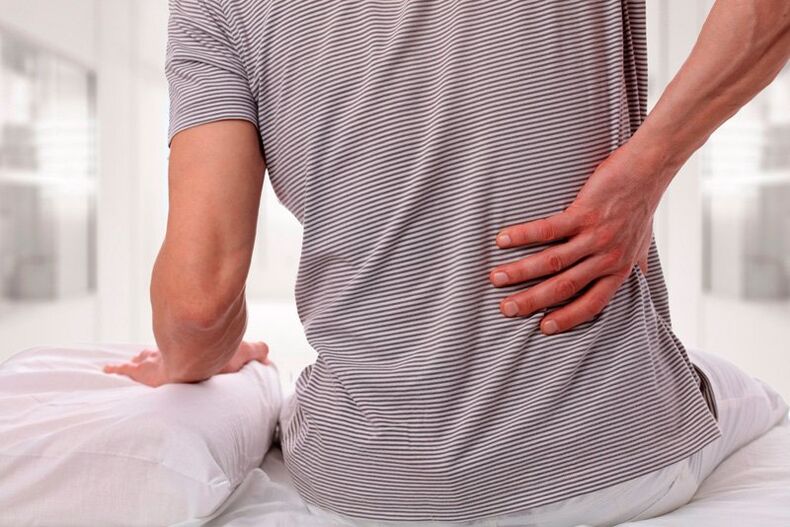Back pain (synonymous with back pain) is one of the most common reasons to visit a doctor, the second after acute respiratory illness1. Most often, such complaints come to a neurologist, therapist or general practitioner. According to international studies, 19 to 43% of the adult population who were interviewed recently noticed back pain in the last month, from 27 to 65% - in the last year. Those who have experienced it at least once in their life are 59-84% 1. Almost one in five adult inhabitants of our planet can experience severe back pain at this time. Their most common localization is the lower back and lower back.

Why does back pain occur?
Among the main reasons for the development of back pain are:
- Vertebral causes - associated with spinal pathology:
- pathology of the intervertebral discs, including hernias;
- narrowing of the spinal canal;
- joint diseases;
- the consequences of accidents;
- congenital malformations and developmental anomalies;
- metabolic disorders;
- spondylitis - inflammatory processes in the intervertebral joints.
- Non-vertebrogenic - not associated with spinal pathology:
- sprains of ligaments and muscles associated with heavy loads;
- myofascial syndrome - chronic muscle pain;
- inflammation of muscle tissue - myositis;
- diseases of the internal organs;
- pathology of the great vessels, for example aneurysm (acute expansion) of the abdominal aorta;
- arthrosis of the hip joint - an inflammatory-dystrophic disease;
- mental disorders, etc.
Depending on the origin, the following types of pain are distinguished:
- Specific- is associated with a specific disease that can be detected by standard examination methods. This type takes up to 3% 1 of all cases. These can be compression fractures of the spine, tumor, infectious processes, diseases of the pelvic organs (especially with back pain in women).
At the same time, there are a number of certain symptoms, the so-called "red flags", which speak of serious diseases and require a thorough examination. These include:
- rapid unreasonable loss of body weight and / or an indication of a history of oncopathology (tumors);
- weakness of the lower limbs, reduced sensation and functions of the pelvic organs (cauda equina syndrome);
- the use of antibiotic therapy, an increase in body temperature (infectious processes);
- previous trauma or previous diagnosis of osteoporosis, aged over 55 (spinal fracture);
- young age - up to 20 years;
- long-term preservation of painful sensations and their intensity, despite treatment;
- combined with general weakness or gait disturbance, aggravated at night, does not change with a change in body position.
- root- subsequent in frequency (up to 27%). It develops as a result of pinching and / or inflammation of the root of the spinal cord, which exits through the openings in the spinal column. This type can be indicated by increased pain during coughing, sneezing, physical exertion, and other types of activity.
- Not specific- more often acute, it is difficult to immediately determine the specific cause of its development, usually they are the consequences of dystrophic changes in the bone, cartilage tissue of the spine, as well as in the muscles and ligaments that make up the supporting apparatus of the back. In the International Classification of Diseases (ICD-10), there is a special section for the definition of these syndromes: dorsopathies.
Such back pain accounts for up to 85% 1 of all cases and is mainly associated with the disruption of the normal functioning of the individual structures of the spine, each of which can become a source of painful impulses. Pain can be compressive (from the compression of the nerve roots) and reflected - from all other tissues, including spasmodic muscles.
Another type of pain syndrome is described, which is not associated with any organic lesions of the spine and paravertebral tissues. This is called dysfunctional pain. It can be caused by psychological problems and chronic stress.
Localization distinguishes:
| What is the name of | Where does it hurt |
| neck pain | neck pain |
| cervicocranilagia | neck + head |
| cervicobrachialgia | neck and gives to the hand |
| thoracalgia | thoracic back and chest pain, pain under the shoulder blades from the back |
| lumbodynia | lumbar and lumbosacral region |
| sciatica | lower back + leg |
| sacralgia | sacred |
| coccygodynia | coccyx |
In addition to the reasons, it is possible to identify factors that can provoke the development of pain syndrome:
- severe physical overload, resulting in excessive stretching of muscles and ligaments;
- uncomfortable or static postures that a person takes for a long time;
- untrained muscles and their overload, inactivity;
- trauma and microtrauma;
- hypothermia;
- prolonged immobility, such as bed rest;
- alcohol abuse;
- diseases of the internal organs;
- joint pathology;
- overweight;
- individual characteristics: curvature of the spine, curvature;
- poor nutrition, diseases of the digestive system, which can be accompanied by impaired absorption of vitamins, mineral metabolism, a significant supply of salts that affect the joints;
- occupational hazards: thermal effects, temperature changes, vibrations, work with weights, etc.
The mechanism of development of back pain is associated with a blockage of the intervertebral joints, which can be caused by loads, both static and dynamic, microtrauma and non-physiological postures. As a result, muscles contract and stretch excessively in one place, and stretch excessively in another. All this leads to the development of muscle pain, changes in pain sensitivity and the formation of pathological pain impulses.
Also, muscle spasm can be a reflex reaction to the pathology of the spine or diseases of the internal organs. In this case, it is seen as a defensive reaction, but at the same time a new circle of pain begins. In addition, with prolonged preservation of the spasm, the transmission of nerve impulses to muscle fibers is disrupted, they become more excitable, a calcium deficiency may occur, and circulatory disorders further aggravate the situation.
Depending on the duration of the back pain, there may be:
- acute - lasting up to 6 weeks;
- subacute - from 6 to 12 weeks;
- chronic - last 12 weeks or more.
Symptoms
Symptoms of back pain depend on the cause, the mechanism of development and the presence of concomitant diseases.
For non-specific pain, the following signs are characteristic:
- aching or pulling, sometimes tightening pain;
- increases with the load or movements of the spine, as well as in certain positions, may decrease when kneading or rubbing the muscles, as well as after resting in a comfortable position;
- possible pain in the sides of the back or pain in the back of the back;
- during probing, compaction, changes in contours, tension are determined, but there are no sensitivity disorders in the painful area, a decrease in muscle strength, reflexes do not change.
When the nerve root is compressed (radiculopathy), the pain differs in its intensity, can be excruciating, often radiates to the leg, and in the limb it can be stronger than in the back. On examination, symptoms of damage to a specific nerve root are observed: muscle weakness, reduced sensitivity in a certain area.
Diagnostics
The diagnostic algorithm for acute and chronic back pain is slightly different.
Sharp pain
In order to determine the tactics of treatment, the doctor should, if possible, determine the cause of the pain syndrome: pinched nerves or their roots, trauma, tumors, inflammation, infections, osteoporosis, diseases of internal organs, etc. As a rule, these types of pain have quite vivid and specific clinical manifestations. After examination and palpation, patients are referred to the appropriate specialists or for further examinations, for example:
- X-ray examination;
- MRI and CT of the spine;
- scintigraphy - a method of visualization that uses the introduction of a contrast agent;
- densitometry - determination of bone density;
- laboratory tests to determine tumor markers, rheumatic tests, biochemical blood tests, etc.
Patients with acute non-specific pain usually do not need further research.
Chronic pain
Since the mechanisms of its development have not yet been sufficiently studied, it can be problematic to identify the source, especially if it is a dysfunctional species that reflects the pathology of other organs. It can be a manifestation of such diseases as irritable bowel syndrome, chronic cystitis, chronic pyelonephritis and others. In each case, a thorough interview and examination of the patient is carried out to decide on further treatment tactics.
For pain syndrome that occurs against the background of dystrophic changes in the joints, after any mechanical stress or under the influence of other factors, MRI can be used to monitor the dynamics of the state of the spine.
How to deal with acute back pain
Physicians who adhere to the principles of evidence-based medicine use the following tactics for the management of patients with acute back pain:
- inform the patient about the causes of the pain syndrome;
- exclude bed rest and recommend maintaining usual activity;
- prescribe effective drug and non-drug treatment;
- monitor the dynamics and regulate therapy.
When choosing a drug, attention is paid to its analgesic effect, speed of action and safety. First of all, non-specific anti-inflammatory drugs (NSAIDs) are prescribed, as their effectiveness has been proven for back pain. One such drug is naproxen.
Naproxen is available in the form of an oral tablet and gel for external use. The drug is indicated as a pain reliever for back pain associated with trauma, overload, inflammation. It also has anti-inflammatory and antipyretic effects, the duration of the effect can last up to 12 hours. If you do not have the opportunity to visit a doctor soon and the pain causes significant discomfort, you can take naproxen as follows: 2 tablets as a starting dose and then 2 tablets every 12 hours or 1 tablet every 8 hours. The course of admission without consulting a doctor lasts no more than 5 days.
While maintaining the intensity of pain, other groups of painkillers and sedatives (sedatives) can be prescribed.
Non-drug treatments include:
- heating;
- manual therapy;
- Physiotherapy;
- massage;
- Physiotherapy;
- acupuncture and other alternative methods.
Treatment of chronic back pain
If it is possible to identify the localization of pain and the source of painful impulses, local therapy is used: blockages, intradiscal influences and other procedures. For the rest of the patients, no such treatment for back pain and low back pain is used, so a different treatment regimen is used. Its main goal is to reduce the intensity of pain and preserve the quality of life.
Also, as in acute pain, drugs from the NSAID group are prescribed, including naproxen, other analgesics, muscle relaxants and vitamins B3. Antidepressants are recommended as needed. Manual therapy should be carried out by a qualified specialist, physical therapy is prescribed. Psychotherapeutic and physiotherapeutic methods of treatment are used.
Prophylaxis
For the prevention of back pain it is necessary to identify all possible risk factors and work to eliminate them.
For all types of pain, the following will be useful:
- adequate physical activity and muscle strengthening, including the back;
- timely treatment of chronic diseases of internal organs;
- maintain a physiological posture during work;
- quitting smoking and alcohol;
- regular preventive examinations;
- adequate treatment and prevention of infections;
- balanced diet;
- wear comfortable shoes and clothes;
- correct organization of work and life to protect the back;
- prevention of stress and emotional overload.

Comprehensive treatment and full-fledged rehabilitation of patients with back pain allows you to preserve the quality of life, reduce the number of cases of disability and prevent the transition to a chronic form of the disease.

































